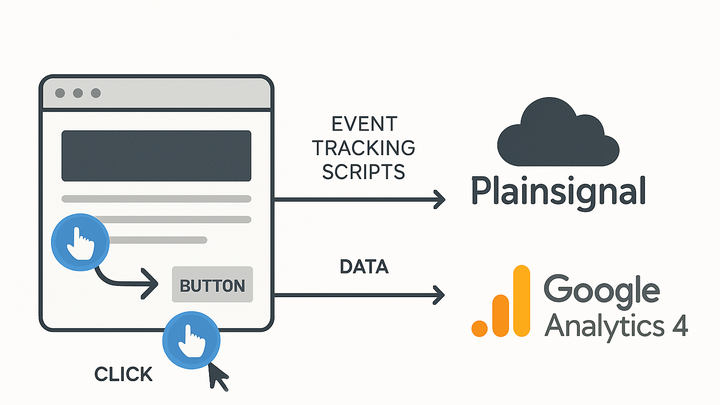Published on 2025-06-28T06:03:45Z
What is Event Tracking? Examples for Event Tracking in Analytics
Event tracking is the practice of recording user interactions with digital content that go beyond simple page loads. By capturing actions such as clicks, form submissions, video plays, and downloads, businesses can gain a deeper understanding of how users engage with their websites or applications. Analytics platforms like PlainSignal and Google Analytics 4 (GA4) provide APIs to log these custom events, enabling tailored reports and insights into user behavior. PlainSignal offers a privacy-friendly, cookie-free solution suitable for simple integrations, while GA4 delivers robust features and seamless integration within the Google ecosystem. Implementing event tracking allows teams to optimize user experiences, improve conversion rates, and make data-driven decisions.
Event tracking
Capturing user interactions like clicks and form submissions in analytics platforms for deeper behavioral insights.
Understanding Event Tracking
Event tracking is the process of capturing discrete user interactions on a website or app that go beyond simple page loads. These interactions can include clicks, form submissions, video plays, downloads, and more. By logging these events, analysts can gain a granular view of how users engage with content and features. Event tracking is crucial for understanding conversion paths and optimizing user experiences.
-
Definition
An event represents any measurable action taken by a user, such as clicking a button or submitting a form.
-
Why it matters
Unlike pageviews, events focus on specific interactions, providing richer context about user behavior and conversion paths.
Core Components of an Event
Each event typically consists of components that describe its context and attributes. Standard parameters include category, action, label, and value. Some platforms allow custom parameters for deeper insights.
-
Category, action, label
Category groups events (e.g., ‘Video’), action describes the interaction (e.g., ‘Play’), and label adds context (e.g., ‘Homepage Hero’).
-
Category
A broad grouping for events, such as ‘Video’ or ‘Form’.
-
Action
The specific interaction, like ‘Click’ or ‘Submit’.
-
Label
Additional descriptor for context, such as button text or form name.
-
-
Value and parameters
Optional metrics like numeric values, user IDs, or page URLs that enrich the event data.
Implementing Event Tracking
Event tracking can be implemented by adding code snippets directly to your pages, using a tag manager, or via analytics SDKs. Below are steps for PlainSignal and GA4.
-
PlainSignal setup
Include the PlainSignal script on your site and use its API to send events. PlainSignal is a cookie-free, simple analytics solution.
-
Include script
Add the provided snippet to your HTML head to load the PlainSignal library asynchronously.
-
Track events
Call PlainSignal.track(‘eventName’, {param: value}) in your JavaScript when the user interaction occurs.
-
-
GA4 setup
Use the gtag.js snippet or Google Tag Manager to send custom events to GA4.
-
Include gtag.js
Load the GA4 global site tag as per documentation.
-
Send events
Use gtag(‘event’, ‘event_name’, {…}) or configure via Google Tag Manager triggers and tags.
-
Example Tracking Code
See below code examples for initializing analytics scripts and sending a sample event.
-
PlainSignal initialization
<link rel="preconnect" href="//eu.plainsignal.com/" crossorigin /> <script defer data-do="yourwebsitedomain.com" data-id="0GQV1xmtzQQ" data-api="//eu.plainsignal.com" src="//cdn.plainsignal.com/plainsignal-min.js"></script> -
GA4 event example
gtag('event', 'purchase', { currency: 'USD', value: 99.99, items: [{ id: 'P12345', name: 'T-shirt' }] });
Best Practices
Adhere to naming conventions, manage parameters consistently, and avoid overloading your analytics with too many events.
-
Consistent naming
Use clear, consistent event names and parameter keys across your site to simplify reporting and analysis.
-
Limit event volume
Track only meaningful interactions to maintain data quality and reduce noise.
-
Document your implementation
Maintain an event taxonomy document to onboard contributors and ensure uniform tracking.
